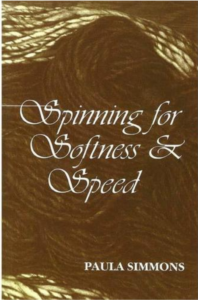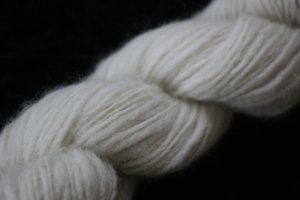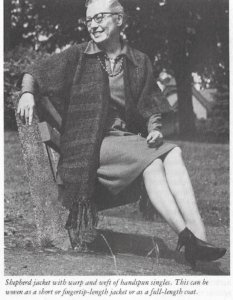Book Review: Spinning for Softness and Speed by Paula Simmons
reviewed by Sukrita Mahon
 I have loved poring over the local Guild’s library books on handspinning techniques from the 1970s, with their black and white photos and descriptions that often leave me more mystified than before. My rewards seem to lie in the knowing that there are some things that never change no matter how much time passes; spinning technique (and the mysteries it entails) is apparently one of them.
I have loved poring over the local Guild’s library books on handspinning techniques from the 1970s, with their black and white photos and descriptions that often leave me more mystified than before. My rewards seem to lie in the knowing that there are some things that never change no matter how much time passes; spinning technique (and the mysteries it entails) is apparently one of them.
So I was intrigued when I first heard of this book because it seemed to contain the promise of an alternative mode of thinking, of approaching spinning in a completely different way from how it’s usually practised and taught. A technique, maybe, that was begging for a revival, close to 4 decades after it had been published. Despite being out of print and somewhat expensive for its size, I was determined to get my hands on it.
Available from a few sellers online, the book is easier to obtain in the U.S. than here in Australia, although not impossible. At only 91 pages in length, spinners may question how it compares to the limitless resources of video content, paid and free, that we have access to today – not to mention the obvious lack of a necessity for speedy spinning since most of us are doing it in order to slow down.
The technique Simmons describes is essentially an unsupported long draw on a spinning wheel, used to spin a soft single that remains a single. It is suited for all kinds of fibres and preparations, which are described in some detail. She touches on spinning yarn for sale, for which this technique would be useful due to the economy of materials and time involved. The idea is to let the wheel do the majority of the work, while the spinner maintains a gentle hold on the fibre, allowing it to be drawn in at a comfortable pace.
The idea of spinning a soft single raises a couple of immediate questions: Will the yarn be stable without plying? What projects will it be suitable for? Simmons does her best to answer these, in addition to describing how she uses a singles handspun yarn for warp thread – a concept I don’t think I’ve come across anywhere before. Most spinners and weavers are vehement about using handspun singles yarn strictly as weft; I was fascinated to read this didn’t necessarily have to be the case.
The method seems to have many benefits: spinning without looking, more efficiently and without “unnecessary hand movements”; controlling over-twist; and potentially resulting in a more even and balanced yarn. I find myself reading certain parts over and over again, to fully absorb the graceful, effortless picture being presented, wondering if one day, I too could read a book while spinning long draw.
I will admit I learn best from videos and in-person demonstrations than from written descriptions. So it wasn’t too surprising that, despite the detailed photos on hand position, the descriptions of how it “should” feel, and even descriptions of common mistakes, I wasn’t quite able to nail down the one-handed technique at the first, or even tenth, go. I really wanted to! I wanted this dreamy, lofty, took-me-one-podcast-episode single in my life!

photo by Sukrita Mahon
Simmons is still encouraging; she says the goal isn’t to do away with using the other hand altogether, but just to minimise its use as much as possible. With this additional context, and having watched a few captivating videos of Abby Franquemont demonstrating, I found myself finally able to do the unsupported long draw, if only in short bursts. Although I’m far from being able to produce the yarn described by Simmons – even, soft, balanced, and somehow incredulously also suitable as warp – I believe the practice is worthwhile. The resulting yarn was beautiful and not at all flimsy. I found, to my surprise, that it held together better than the worsted-spun singles I often make.
 Readers may find some of the information in the book potentially redundant – such as the chapter on spinning wheels, which seem to have changed a bit since the 1980s. The historically inclined spinner or collector of older wheels may find this chapter interesting, especially since there is a section dedicated to using the technique on the Great Wheel or Walking Wheel.
Readers may find some of the information in the book potentially redundant – such as the chapter on spinning wheels, which seem to have changed a bit since the 1980s. The historically inclined spinner or collector of older wheels may find this chapter interesting, especially since there is a section dedicated to using the technique on the Great Wheel or Walking Wheel.
The book contains 2 projects that use soft-spun singles, a woven jacket and a knitted vest. They are both potential wardrobe staples, although the jacket is likely a clear winner in terms of wearability and current fashion. Not being a weaver myself yet, I’m unable to speak to the originality of the garment construction, but I find its simplicity and ease alluring.
All in all, I think Spinning for Softness and Speed makes a charming addition to any spinning book collection. It contains many curious details for a casual spinning-history buff while still having relevance to our present-day practice. I would not say the method is easy or that it’s for everyone; some may try it once and never again. It isn’t really novel either, of course, and there are many other resources for learning unsupported long draw that may be more accessible and informative. The exact descriptors used in the book seem unique however, and some may find the insights useful to help things “click.”
If you enjoy reading unconventional perspectives on spinning methods, you may love this book. And if you learn best from photos and the written word, Simmons is a masterful teacher that you can’t go wrong with.
Rating: 3.5/5



